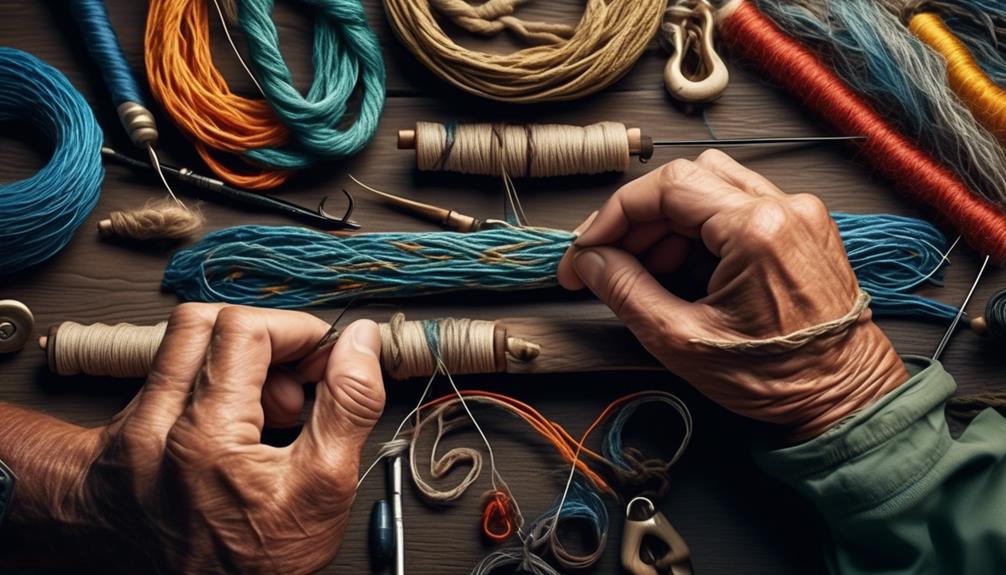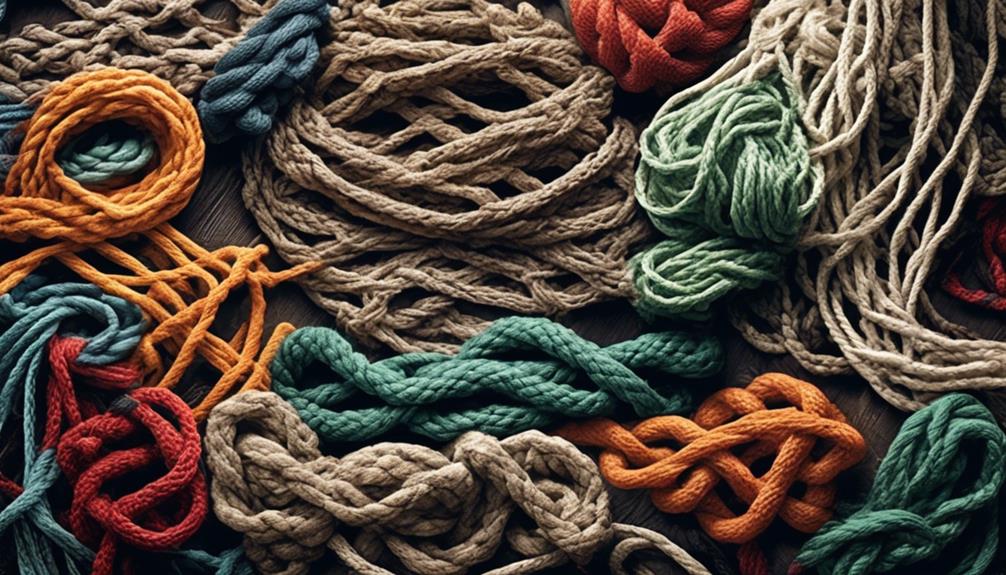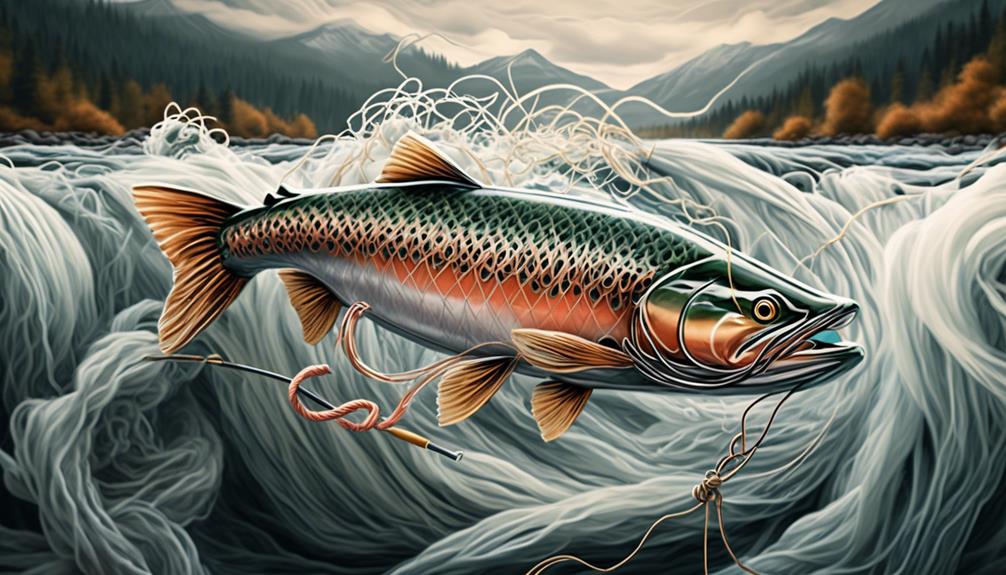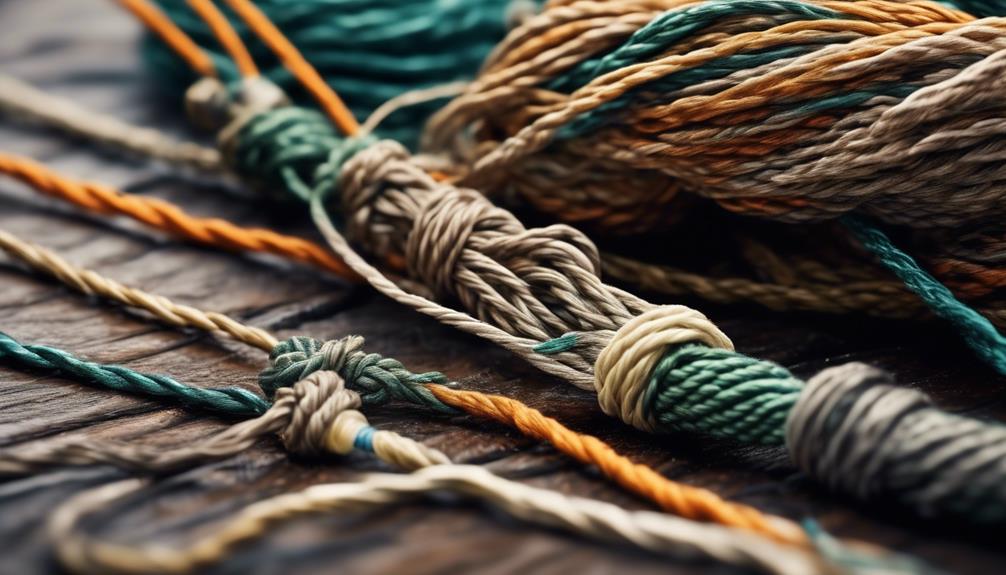Tying fishing knots is like weaving a strong safety net for your catch, ensuring that it stays secure and doesn't slip away. With so many different knots to choose from, it can be overwhelming to know which ones will serve you best in various fishing scenarios.
But fear not, as we've compiled eight helpful tips to demystify the art of diverse fishing knots. Whether you're a seasoned angler or just starting out, these tips will equip you with the knowledge and skills to effectively tie the right knot for the right job.
So, let's dive into the world of diverse fishing knots and unravel the secrets to mastering them.
Understanding Knot Strength
To understand knot strength, you need to consider the materials and techniques used to tie the knot. The material of the line and the specific knot used will determine the overall strength of the knot. Different fishing lines have varying degrees of elasticity, which directly impacts the strength of the knot. For instance, monofilament lines have more stretch compared to braided lines, affecting how the knot holds.
It's essential to compare knot strength to line strength. While the line itself has a certain strength rating, the knot tied in it will inherently weaken it. Understanding this relationship is vital. For example, if you have a line with a 20-pound test strength, tying a knot in it may reduce its overall strength to 15 or 16 pounds. Therefore, the choice of knot becomes crucial in maintaining the integrity of the line's strength.
Certain knots are known for retaining more line strength than others, so choosing the right knot for the type of fishing line and the situation is key.
Selecting the Right Knot for the Job
Understanding the strength of different fishing lines and the impact of knots on their integrity, you can now focus on selecting the right knot for the job. When it comes to selecting the appropriate knot, it's crucial to consider the specific fishing line you're using and the technique you'll employ. Different knots are tailored for specific fishing line compatibility and knot tying techniques.
For instance, the Palomar knot is renowned for its strength and is ideal for braided lines, while the improved clinch knot is well-suited for monofilament lines.
Additionally, the knot tying technique plays a significant role in selecting the right knot. Some knots are easier to tie, making them preferable for scenarios where you need to quickly re-rig your line. The loop knot, for example, allows for greater lure movement and is quick to tie, making it a great choice for changing lures frequently. On the other hand, the blood knot is more intricate to tie but excels in joining two lines of similar diameter.
Considering these factors, it's essential to match the fishing line compatibility and knot tying techniques with the specific requirements of your fishing situation. By doing so, you can ensure that the knot you select will provide the required strength and integrity, enhancing your chances of a successful fishing experience.
Mastering the Palomar Knot
Want to learn the key steps to mastering the Palomar Knot in your fishing endeavors? The Palomar knot is a strong and reliable knot that's easy to tie, making it a favorite among anglers. To effectively secure your fishing line, mastering the Palomar knot is essential.
Here are some knot tying techniques and tips for securing your fishing line using the Palomar knot.
To tie the Palomar knot, start by doubling about 6 inches of line and passing it through the eye of the hook. Then, tie a simple overhand knot in the doubled line, forming a loop. Next, pass the loop over the hook and cinch it down. Make sure the loop is large enough to easily pass over the hook. Finally, wet the line and pull both ends to tighten the knot. This creates a strong and secure connection between your line and the hook.
When securing your fishing line with the Palomar knot, ensure that the knot is pulled tight to prevent slippage. After tying the knot, trim any excess line to avoid interference with your bait or lure. Additionally, always inspect the knot for any signs of weakness or damage before casting your line.
Exploring the Improved Clinch Knot
Exploring the Improved Clinch Knot can enhance your fishing skills and increase the strength of your line connections. This versatile knot is widely used by anglers due to its reliability and simplicity. By understanding the advantages of the improved clinch knot and avoiding common mistakes in tying it, you can significantly improve your fishing experience.
Here are some advantages of the improved clinch knot:
- Reliability: The improved clinch knot is known for its strength and ability to hold up against powerful fish.
- Versatility: It can be used with various types of fishing lines, making it a versatile choice for different fishing scenarios.
- Ease of Tying: Once mastered, the improved clinch knot can be tied quickly and easily, saving time on the water.
- Effective with Lures: This knot is particularly effective when attaching lures or hooks to the line, providing a secure connection.
- Minimal Line Waste: Unlike some other knots, the improved clinch knot requires minimal line length, reducing waste and saving resources.
Common mistakes in tying the improved clinch knot include:
- Failure to Wet the Knot: Not moistening the knot before tightening can cause friction and weaken the line.
- Overlapping Wraps: Making too many wraps when tying the knot can lead to a bulky and less secure connection.
- Insufficient Tightening: Failing to properly cinch the knot can result in slippage and potential breakage.
- Cutting the Tag End Too Close: Trimming the tag end too closely may cause the knot to unravel over time.
- Using Damaged Line: Tying the improved clinch knot with frayed or damaged line reduces its strength and reliability.
Learning the Uni Knot for Versatility
To expand your repertoire of essential fishing knots, mastering the Uni Knot adds versatility to your angling skills, complementing the reliability and simplicity of the improved clinch knot. The Uni Knot, also known as the Duncan Knot, is incredibly versatile and has a wide range of applications and advantages.
This knot can be used for attaching hooks, swivels, and lures, making it an indispensable tool for both freshwater and saltwater fishing. Its strength and ease of tying make it a favorite among anglers for various fishing scenarios.
One of the key advantages of the Uni Knot is its versatility. It can be used with a variety of fishing lines, including monofilament, fluorocarbon, and braided lines, making it suitable for different fishing techniques and situations. Whether you're fishing for bass, trout, or saltwater species, the Uni Knot provides a reliable and strong connection between your line and terminal tackle.
When it comes to tying techniques and variations, the Uni Knot offers flexibility. Once mastered, you can easily adapt the Uni Knot to create variations such as the Double Uni Knot for joining lines of different diameters, or the Uni-to-Uni Knot for connecting two lines together. Additionally, the Uni Knot can be tied quickly, even in adverse weather conditions, making it a practical choice for anglers on the water.
Tying the Strong and Reliable Blood Knot
The blood knot is a highly reliable and strong knot used in fishing to join two lines together securely. When tying the blood knot, it's essential to pay close attention to the techniques to ensure maximum knot security.
- Use Similar Diameter Lines: Ensure that the lines you're joining together have a similar diameter. This will help in creating a more secure and balanced blood knot.
- Create Overlapping Loops: Form two overlapping loops with the ends of the lines, ensuring that they're parallel to each other to facilitate easier wrapping.
- Wrap the Lines: Wrap one end around the other line 4-6 times, then thread it through the center in the opposite direction. Repeat the same process with the other end.
- Moisten the Knot: Before tightening the knot, moisten it with a bit of water or saliva. This will reduce friction and heat, allowing the knot to tighten smoothly.
- Pull Tight and Trim Excess: After carefully tightening the knot, ensure both ends are pulled tightly. Trim any excess line close to the knot to prevent interference with the fishing rod's guides.
Mastering the blood knot tying techniques and paying attention to knot security will greatly enhance your fishing experience, providing confidence in the strength and reliability of your line connections.
Utilizing the Surgeon's Knot for Joining Lines
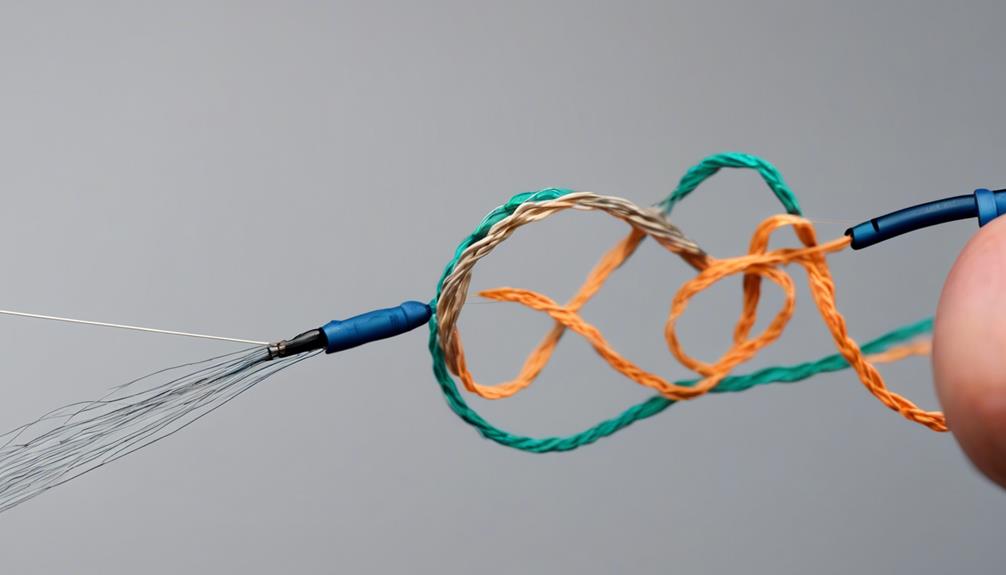
After mastering the strong and reliable blood knot, you can now move on to learning the effective technique of utilizing the Surgeon's Knot for joining lines securely in fishing. The Surgeon's Knot is an essential skill for anglers, especially when dealing with lines of different diameters or materials. This knot is particularly useful for joining lines of similar or different diameters and is known for its simplicity and strength.
When utilizing the Surgeon's Knot, it's crucial to consider the compatibility of the lines being joined. Whether it's monofilament to fluorocarbon, braid to mono, or any other combination, understanding the characteristics of each line is essential. This knowledge will help you determine the appropriate double line joining technique and ensure a secure connection.
Knot tension plays a vital role in the effectiveness of the Surgeon's Knot. Properly tightening the knot is crucial to prevent slippage and maintain the strength of the connection. Be sure to apply consistent pressure during the tying process to achieve the desired level of tension, ensuring that the knot is snug and secure.
One of the key advantages of the Surgeon's Knot is its simplicity. Anglers of all skill levels can quickly master this joining technique, making it a valuable addition to their repertoire of fishing knots. With its ability to securely link lines while maintaining a high level of strength, the Surgeon's Knot is a go-to choice for many fishing scenarios.
Perfecting the Loop Knot for Lures
Mastering the art of tying a secure and versatile loop knot for lures is essential for enhancing your fishing technique and increasing your chances of a successful catch. When it comes to perfecting the loop knot for lures, there are specific benefits and techniques that you should keep in mind:
- Loop Knot Benefits:
- Allows lures to move more naturally in the water, attracting fish with a lifelike presentation.
- Enhances the action of certain lures, such as topwater baits, by providing greater freedom of movement.
- Minimizes line twist, which is especially beneficial when using spinners or spoons.
- Provides a strong and reliable connection between the lure and the line, reducing the risk of losing a catch due to knot failure.
- Offers versatility, as it can be used with a wide range of lures and fishing conditions.
- Lure Attachment Techniques:
- Begin by doubling the line to form a small loop, allowing the lure to move freely.
- Pass the doubled line through the lure's eye or attachment point.
- Tie an overhand knot with the doubled line, leaving the loop at the desired size for the lure to move naturally.
- Pass the lure through the loop.
- Moisten the knot and pull it tight, ensuring that the loop maintains its size and the knot is secure.
Frequently Asked Questions
Are There Any Specific Fishing Scenarios Where the Surgeon's Knot Should Be Avoided?
When it comes to fishing knot alternatives, there are specific scenarios where you should avoid using the surgeon's knot. Avoiding surgeon's knot pitfalls is important, especially when dealing with heavy lines or when you need a knot with a lower profile.
In these situations, it's best to opt for other knots like the improved clinch knot or the Palomar knot, which offer better strength and reliability.
What Are Some Common Mistakes to Avoid When Tying the Improved Clinch Knot?
When tying the improved clinch knot, common mistakes to avoid include not moistening the line before cinching and failing to ensure that the wraps are neat and tight. By avoiding these errors, you'll improve the knot's strength and reliability.
While the surgeon's knot has its uses, it's best to avoid it in scenarios where a smoother profile is needed, such as when attaching the leader to the fly line in fly fishing.
Can the Uni Knot Be Used for Connecting Different Types of Fishing Lines, Such as Monofilament to Braided Line?
Yes, the uni knot can be used for connecting different types of fishing lines, such as monofilament to braided line. It's versatile and works well with various line types, making it a favorite among anglers.
When tying uni knot variations, ensure that the wraps are consistent and tight for maximum strength.
With attention to detail, you can successfully use the uni knot for various fishing line compatibility needs.
Are There Any Tips for Tying the Palomar Knot in Windy Conditions?
When tying the Palomar knot in windy conditions, it's essential to secure your fishing equipment. To improve your tying techniques, find a sheltered spot to minimize wind interference.
Utilize your body as a barrier against the wind and maintain tension on the line until the knot is fully secured. Additionally, consider wetting the line before tying to reduce friction and increase the knot's strength.
These tips will help you master the Palomar knot in challenging windy conditions.
How Can the Strength of a Blood Knot Be Affected by Different Types of Fishing Line?
When comparing the strength of a blood knot with different types of fishing line, it's important to consider how the knot performs with various line variations. The strength may be affected by factors such as the thickness and material of the line.
Different line types can have varying degrees of flexibility and tensile strength, which can impact how well the blood knot holds.
It's essential to test the knot with different lines to determine its performance.
Conclusion
Now that you've learned about various fishing knots, you can confidently tackle any fishing situation.
Remember to consider knot strength and the specific job at hand when selecting the right knot.
Practice tying the Palomar, Improved Clinch, Uni, Blood, Surgeon's, and Loop knots to master their techniques.
With these skills in your arsenal, you'll be well-equipped for a successful and enjoyable fishing experience.
Happy fishing!
